Propagation Characteristics of Circular Airy Vortex Beams in a Uniaxial Crystal along the Optical Axis
Abstract
:1. Introduction
2. Theory Model
3. Numerical Study
3.1. CAB with On-Axis OV
3.2. CAB with Off-Axis OVs
4. Conclusions
Author Contributions
Funding
Conflicts of Interest
References
- Efremidis, N.K.; Christodoulides, D.N. Abruptly autofocusing waves. Opt. Lett. 2010, 35, 4045–4047. [Google Scholar] [CrossRef] [PubMed]
- Papazoglou, D.G.; Efremidis, N.K.; Christodoulides, D.N.; Tzortzakis, S. Observation of abruptly autofocusing waves. Opt. Lett. 2011, 36, 1842–1844. [Google Scholar] [CrossRef] [PubMed]
- Liu, S.; Wang, M.; Li, P.; Zhang, P.; Zhao, J. Abrupt polarization transition of vector autofocusing Airy beams. Opt. Lett. 2013, 38, 2416–2418. [Google Scholar] [CrossRef] [PubMed]
- Jiang, Y.; Huang, K.; Lu, X. Propagation dynamics of abruptly autofocusing Airy beams with optical vortices. Opt. Express 2012, 20, 18579–18584. [Google Scholar] [CrossRef] [PubMed]
- Chremmos, I.; Zhang, P.; Prakash, J.; Efremidis, N.K.; Christodoulides, D.N.; Chen, Z. Fourier-space generation of abruptly autofocusing beams and optical bottle beams. Opt. Lett. 2011, 36, 3675–3677. [Google Scholar] [CrossRef]
- Panagiotopoulos, P.; Papazoglou, D.G.; Couairon, A.; Tzortzakis, S. Sharply autofocused ring-Airy beams transforming into non-linear intense light bullets. Nat. Commun. 2013, 4, 2622. [Google Scholar] [CrossRef] [Green Version]
- Dasgupta, R.; Ahlawat, S.; Verma, R.S.; Gupta, P.K. Optical orientation and rotation of trapped red blood cells with Laguerre-Gaussian mode. Opt. Express 2011, 19, 7680–7688. [Google Scholar] [CrossRef]
- Coullet, P.; Gil, L.; Rocca, F. Optical vortices. Opt. Commun. 1989, 73, 403–408. [Google Scholar] [CrossRef]
- Allen, L.; Beijersbergen, M.W.; Spreeuw, R.J.C.; Woerdman, J.P. Orbital angular momentum of light and the transformation of Laguerre-Gaussian laser modes. Phys. Rev. A 1992, 45, 8185–8189. [Google Scholar] [CrossRef]
- Marrucci, L.; Manzo, C.; Paparo, D. Optical Spin-to-Orbital Angular Momentum Conversion in Inhomogeneous Anisotropic Media. Phys. Rev. Lett. 2006, 96, 163905. [Google Scholar] [CrossRef] [Green Version]
- Gibson, G.; Courtial, J.; Padgett, M.J.; Vasnetsov, M.; Pas’ko, V.; Barnett, S.M.; Franke-Arnold, S. Free-space information transfer using light beams carrying orbital angular momentum. Opt. Express 2004, 12, 5448–5456. [Google Scholar] [CrossRef] [PubMed] [Green Version]
- He, H.; Friese, M.E.J.; Heckenberg, N.R.; Rubinsztein-Dunlop, H. Direct Observation of Transfer of Angular Momentum to Absorptive Particles from a Laser Beam with a Phase Singularity. Phys. Rev. Lett. 1995, 75, 826–829. [Google Scholar] [CrossRef] [PubMed] [Green Version]
- Simpson, N.B.; Dholakia, K.; Allen, L.; Padgett, M.J. Mechanical equivalence of spin and orbital angular momentum of light: An optical spanner. Opt. Lett. 1997, 22, 52–54. [Google Scholar] [CrossRef] [PubMed]
- Hnatovsky, C.; Shvedov, V.G.; Krolikowski, W.; Rode, A.V. Materials processing with a tightly focused femtosecond laser vortex pulse. Opt. Lett. 2010, 35, 3417–3419. [Google Scholar] [CrossRef] [PubMed] [Green Version]
- Toyoda, K.; Miyamoto, K.; Aoki, N.; Morita, R.; Omatsu, T. Using Optical Vortex To Control the Chirality of Twisted Metal Nanostructures. Nano Letters 2012, 12, 3645–3649. [Google Scholar] [CrossRef] [PubMed]
- Rozas, D.; Law, C.T.; Swartzlander, G.A. Propagation dynamics of optical vortices. J. Opt. Soc. Am. B 1997, 14, 3054–3065. [Google Scholar] [CrossRef]
- Dai, H.T.; Liu, Y.J.; Luo, D.; Sun, X.W. Propagation dynamics of an optical vortex imposed on an Airy beam. Opt. Lett. 2010, 35, 4075–4077. [Google Scholar] [CrossRef]
- Dai, H.T.; Liu, Y.J.; Luo, D.; Sun, X.W. Propagation properties of an optical vortex carried by an Airy beam: Experimental implementation. Opt. Lett. 2011, 36, 1617–1619. [Google Scholar] [CrossRef]
- Davis, J.A.; Cottrell, D.M.; Sand, D. Abruptly autofocusing vortex beams. Opt. Express 2012, 20, 13302–13310. [Google Scholar] [CrossRef]
- Yariv, A.; Yeh, P. Optical Waves in Crystals; J. Wiley: New York, NY, USA, 1984. [Google Scholar]
- Stamnes, J.J.; Sherman, G.C. Radiation of electromagnetic fields in uniaxially anisotropic media. J. Opt. Soc. Am. 1976, 66, 780–788. [Google Scholar] [CrossRef]
- Stamnest, J.J.; Sherman, G.C. Radiation of electromagnetic fields in biaxially anisotropic media. J. Opt. Soc. Am. 1978, 68, 502–508. [Google Scholar] [CrossRef]
- Fleck, J.A.; Feit, M.D. Beam propagation in uniaxial anisotropic media. J. Opt. Soc. Am. 1983, 73, 920–926. [Google Scholar] [CrossRef] [Green Version]
- Ciattoni, A.; Cincotti, G.; Palma, C. Propagation of cylindrically symmetric fields in uniaxial crystals. J. Opt. Soc. Am. A 2002, 19, 792–796. [Google Scholar] [CrossRef] [PubMed]
- Ciattoni, A.; Cincotti, G.; Palma, C. Circularly polarized beams and vortex generation in uniaxial media. J. Opt. Soc. Am. A 2003, 20, 163–171. [Google Scholar] [CrossRef]
- Khilo, N.A. Diffraction and order conversion of Bessel beams in uniaxial crystals. Opt. Commun. 2012, 285, 503–509. [Google Scholar] [CrossRef]
- Khonina, S.N.; Morozov, A.A.; Karpeev, S.V. Effective transformation of a zero-order Bessel beam into a second-order vortex beam using a uniaxial crystal. Laser Phys. 2014, 24, 056101. [Google Scholar] [CrossRef]
- Brasselet, E.; Izdebskaya, Y.; Shvedov, V.; Desyatnikov, A.S.; Krolikowski, W.; Kivshar, Y.S. Dynamics of optical spin-orbit coupling in uniaxial crystals. Opt. Lett. 2009, 34, 1021–1023. [Google Scholar] [CrossRef]
- Ling, X.; Luo, H.; Guan, F.; Zhou, X.; Luo, H.; Zhou, L. Vortex generation in the spin-orbit interaction of a light beam propagating inside a uniaxial medium: Origin and efficiency. Opt. Express 2020, 28, 27258–27267. [Google Scholar] [CrossRef]
- Zhou, G.; Chen, R.; Chu, X. Propagation of Airy beams in uniaxial crystals orthogonal to the optical axis. Opt. Express 2012, 20, 2196–2205. [Google Scholar] [CrossRef]
- Deng, D.; Chen, C.; Zhao, X.; Li, H. Propagation of an Airy vortex beam in uniaxial crystals. Appl. Phys. B 2013, 110, 433–436. [Google Scholar] [CrossRef]
- Zhou, M.-L.; Chen, C.-D.; Chen, B.; Peng, X.; Peng, Y.-L.; Deng, D.-M. Propagation of an Airy–Gaussian beam in uniaxial crystals. Chin. Phys. B 2015, 24, 124102. [Google Scholar] [CrossRef]
- Yu, W.; Zhao, R.; Deng, F.; Huang, J.; Chen, C.; Yang, X.; Zhao, Y.; Deng, D. Propagation of Airy Gaussian vortex beams in uniaxial crystals. Chin. Phys. B 2016, 25, 044201. [Google Scholar] [CrossRef]
- Ciattoni, A.; Palma, C. Optical propagation in uniaxial crystals orthogonal to the optical axis: Paraxial theory and beyond. J. Opt. Soc. Am. A 2003, 20, 2163–2171. [Google Scholar] [CrossRef]
- Zheng, G.; Deng, X.; Xu, S.; Wu, Q. Propagation dynamics of a circular Airy beam in a uniaxial crystal. Appl. Opt. 2017, 56, 2444–2448. [Google Scholar] [CrossRef]
- Zheng, G.; Xu, S.; Wu, Q.; Wang, Q.; Ouyang, Z. Electro-optical coupling of a circular Airy beam in a uniaxial crystal. Opt. Express 2017, 25, 14654–14667. [Google Scholar] [CrossRef]
- Indebetouw, G. Optical Vortices and Their Propagation. J. Mod. Opt. 1993, 40, 73–87. [Google Scholar] [CrossRef]
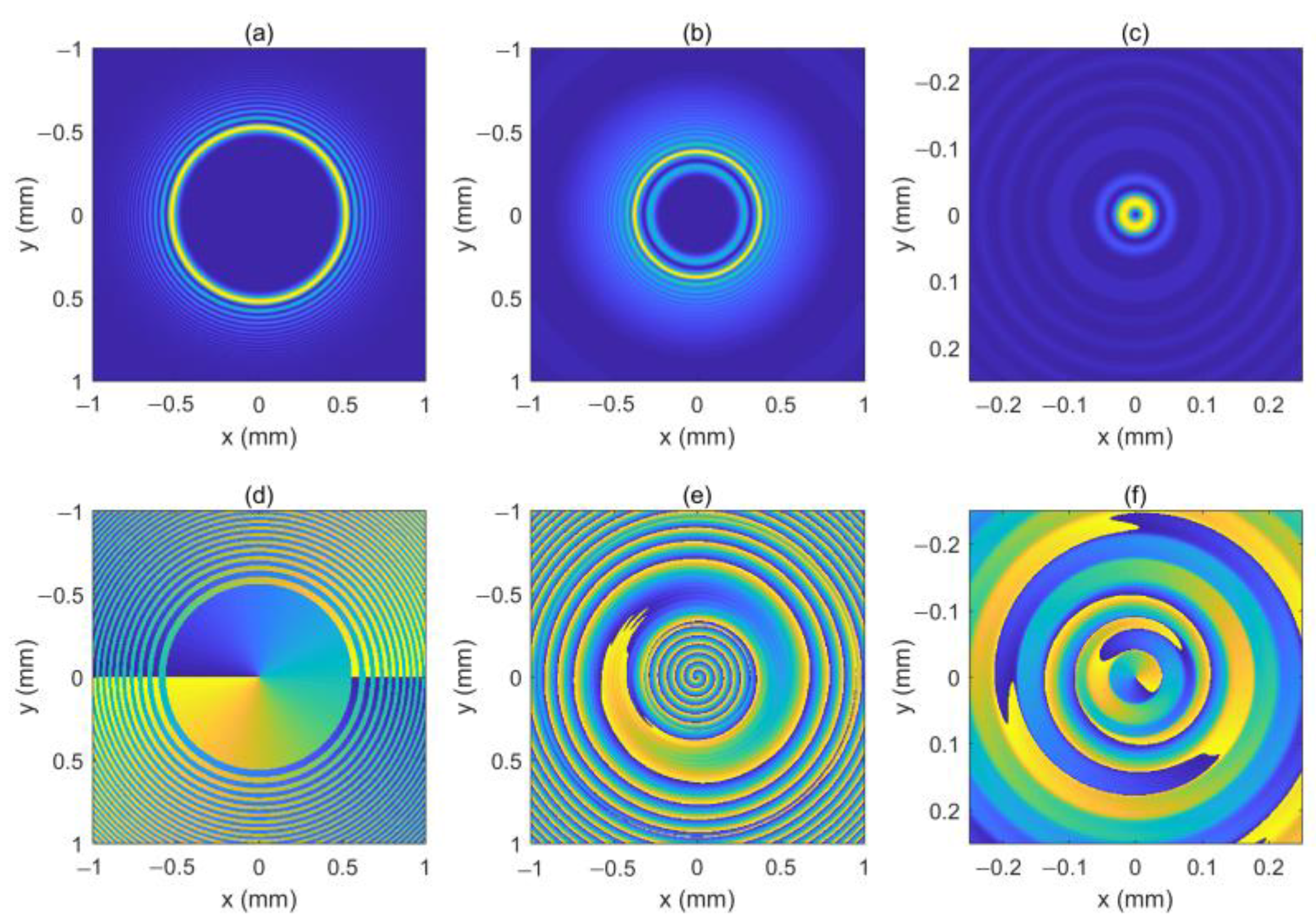
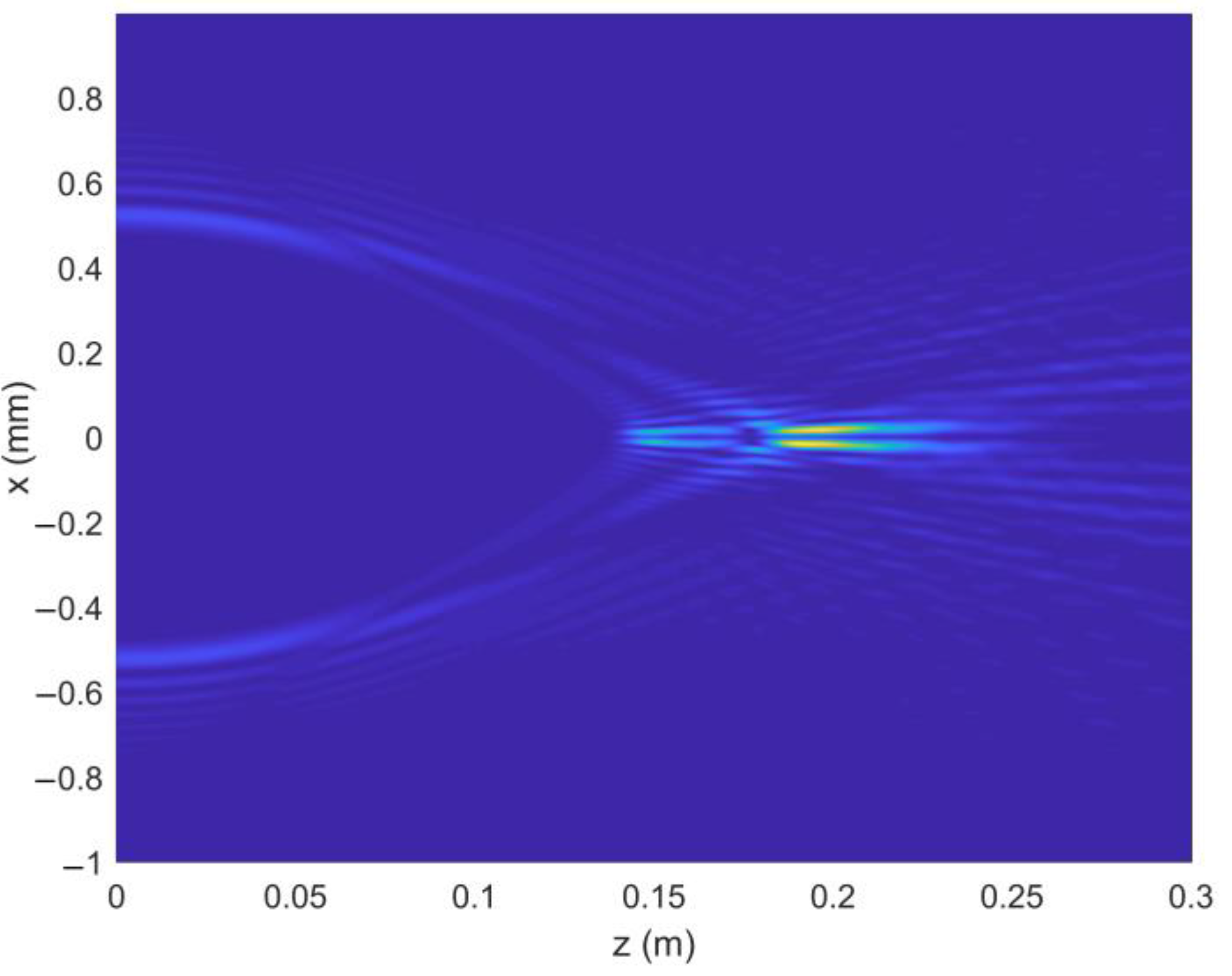
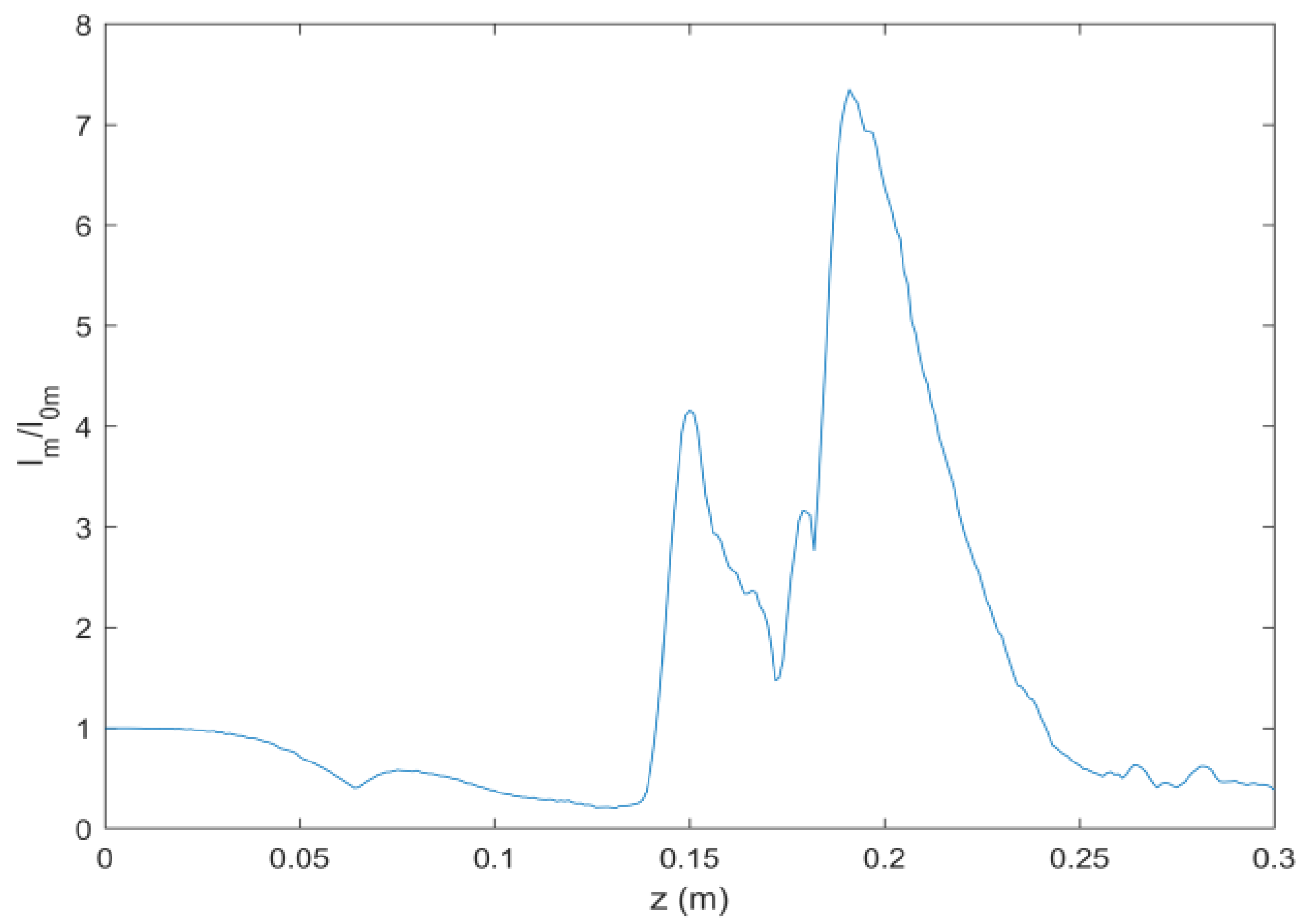
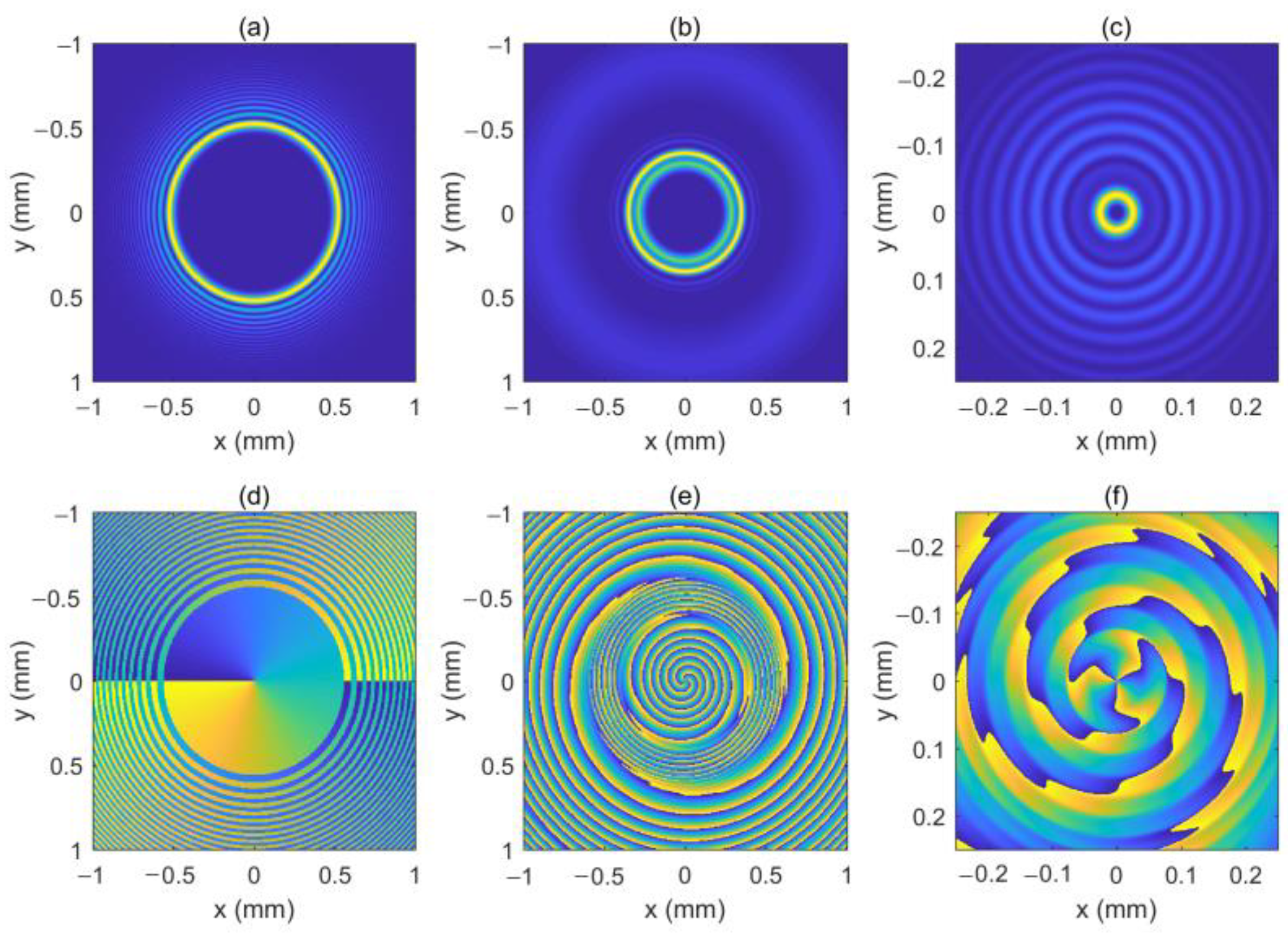




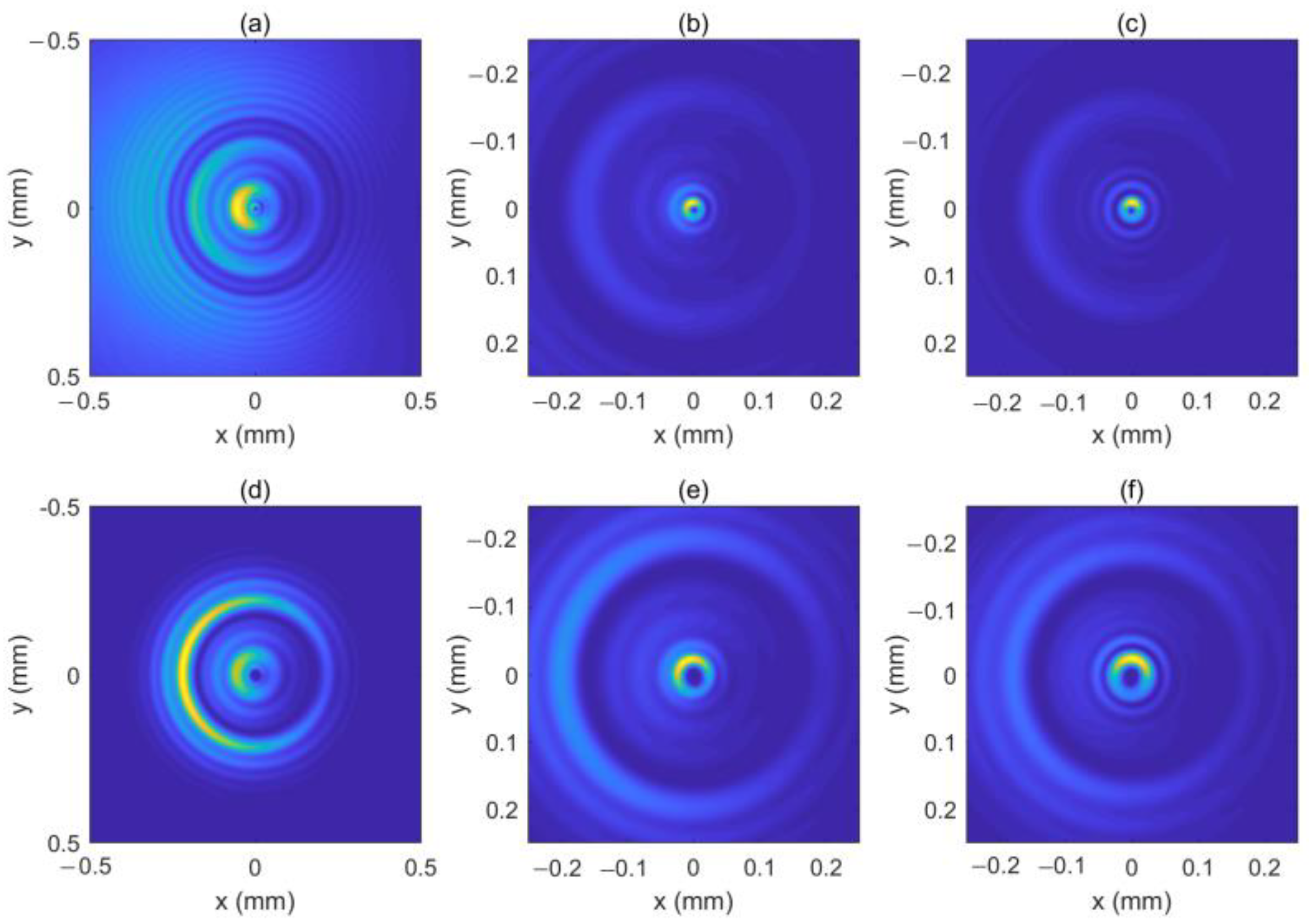
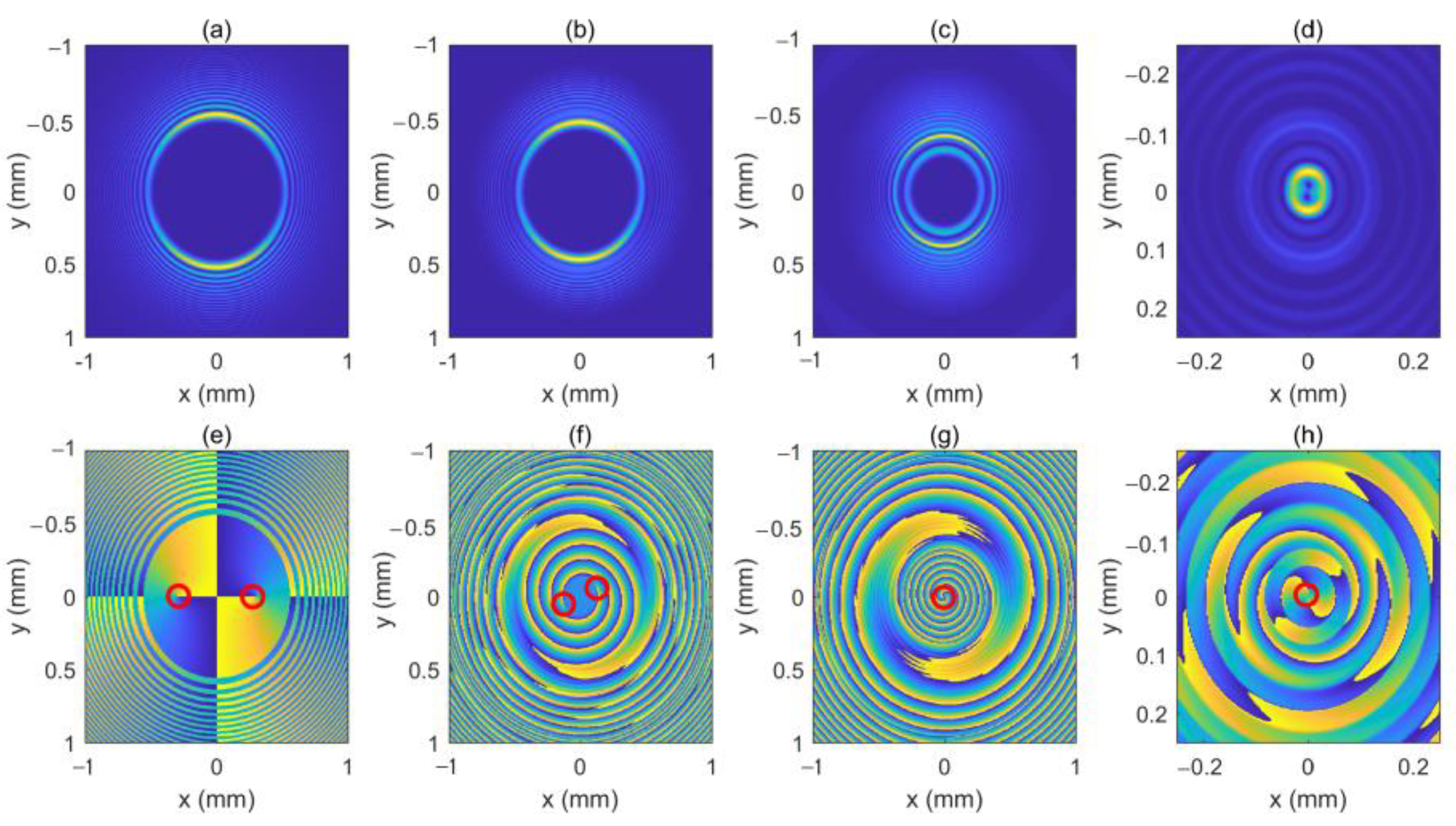


Publisher’s Note: MDPI stays neutral with regard to jurisdictional claims in published maps and institutional affiliations. |
© 2022 by the authors. Licensee MDPI, Basel, Switzerland. This article is an open access article distributed under the terms and conditions of the Creative Commons Attribution (CC BY) license (https://creativecommons.org/licenses/by/4.0/).
Share and Cite
Zheng, G.; Wu, Q.; He, T.; Zhang, X. Propagation Characteristics of Circular Airy Vortex Beams in a Uniaxial Crystal along the Optical Axis. Micromachines 2022, 13, 1006. https://doi.org/10.3390/mi13071006
Zheng G, Wu Q, He T, Zhang X. Propagation Characteristics of Circular Airy Vortex Beams in a Uniaxial Crystal along the Optical Axis. Micromachines. 2022; 13(7):1006. https://doi.org/10.3390/mi13071006
Chicago/Turabian StyleZheng, Guoliang, Qingyang Wu, Tiefeng He, and Xuhui Zhang. 2022. "Propagation Characteristics of Circular Airy Vortex Beams in a Uniaxial Crystal along the Optical Axis" Micromachines 13, no. 7: 1006. https://doi.org/10.3390/mi13071006





